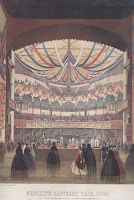 “Healing the Wounds of War: The Brooklyn Sanitary Fair of 1864″- is the title of an exhibition that will run January 29th to October 17th at the Brooklyn Museum (Elizabeth A. Sackler Center for Feminist Art, Herstory Gallery, 4th floor). The exhibit will present a selection of artworks and historical objects celebrating the contributions of women to the mid-nineteenth-century Sanitary Movement, which organized Sanitary Fairs in major cities in the Northeast to raise money for the Civil War effort. Although the U.S. Sanitary Commission was headed by men, most of its work was accomplished by thousands of women volunteers. In Brooklyn, women’s organizations orchestrated the hugely successful Brooklyn and Long Island Sanitary Fair.
“Healing the Wounds of War: The Brooklyn Sanitary Fair of 1864″- is the title of an exhibition that will run January 29th to October 17th at the Brooklyn Museum (Elizabeth A. Sackler Center for Feminist Art, Herstory Gallery, 4th floor). The exhibit will present a selection of artworks and historical objects celebrating the contributions of women to the mid-nineteenth-century Sanitary Movement, which organized Sanitary Fairs in major cities in the Northeast to raise money for the Civil War effort. Although the U.S. Sanitary Commission was headed by men, most of its work was accomplished by thousands of women volunteers. In Brooklyn, women’s organizations orchestrated the hugely successful Brooklyn and Long Island Sanitary Fair.
Highlights of the exhibition include a rare doll made by a young woman named Eliza Lefferts and sold at the Brooklyn Sanitary Fair in 1864- engravings created by Winslow Homer- and the rare book History of the Brooklyn and Long Island Fair, February 22, 1864. The Herstory Gallery is dedicated to exhibitions that elaborate on the lives and
histories of the 1,038 women who are named in Judy Chicago’s The Dinner Party, installed permanently in the adjacent gallery. Represented on The Dinner Party table is Dr. Elizabeth Blackwell, the country’s first female physician and a dedicated pioneer of the Sanitary Movement.
The exhibition has been organized by Catherine Morris, Curator of the Elizabeth A. Sackler Center for Feminist Art, Brooklyn Museum.
Photo: “Brooklyn Sanitary Fair, 1864. View of the Academy of Music as seen from the stage.” Brooklyn Public Library. Brooklyn Collection.








